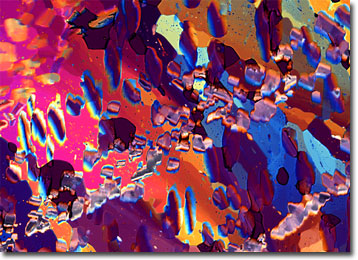Polarized Light Microscopy Digital Image Gallery
Honey (Synthetic)
In nature, honey is the golden, viscous substance produced by bees from flower nectar. The flavor, smell, and appearance of such honey is determined by the kind of flowers visited by the bees that create it, but in the laboratory, scientists are able to create their own versions of honey that display whatever characteristics they want to emphasize.

View a second image of Honey (Synthetic)
Though real honey continues to be popular in candies, cakes, and other baked goods, synthetic versions of the substance have become increasingly prevalent in recent years, especially in commercially made items. Indeed, many of the breakfast cereals, honey-flavored teas, and sweets consumed today contain a honey-flavoring agent rather than the sugary fluid generated by bees. To provide the sweetness that is characteristic of real honey to these products, manufacturers add significant amounts of high fructose corn syrup in addition to the synthetic flavor. The wide availability and low-cost of this sweetener has caused a certain amount of alarm in the honey industry due to the temptation for sellers of honey that is supposed to be pure to adulterate their products with synthetic versions of the substance.
Utilized as a sweetener since antiquity, the aroma of honey is sweet, familiar, and comforting. Thus, it is no surprise that in addition to flavoring edible items, synthetic honey is often utilized as a fragrance. Many items that often include synthetic honey fragrances are designed for personal hygiene, such as soaps, shampoos, conditioners, cosmetics, and body lotions. However, the sweet smell of products such as candles, incense, and potpourri are also often the result of synthetic honey additives.
